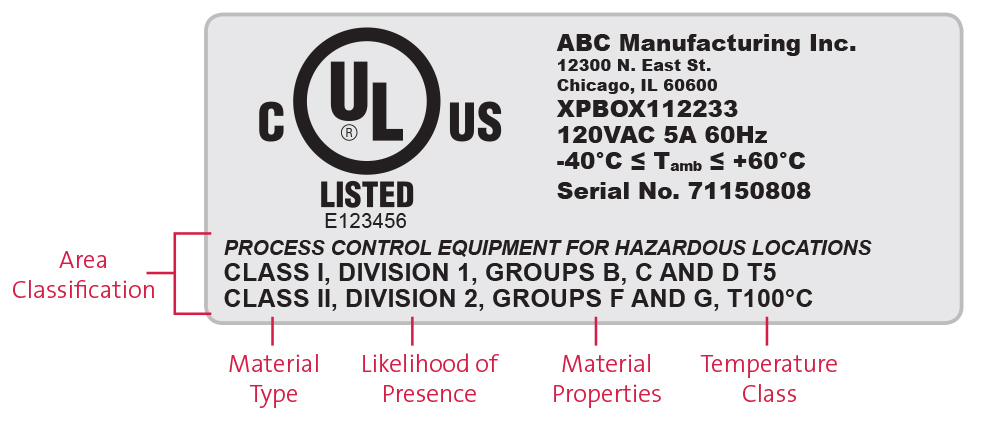Certification for explosion proof lighting is a complex process, requiring compliance with specific standards, formal certification and testing to ensure lighting fixtures are safe for environments prone to accidental fires and explosions. There are several industry standards and certifying bodies involved in this process, including the National Electrical Code (NEC), International Electrotechnical Commission (IEC), and European Committee for Electrotechnical Standardization (CENELEC), among others.
These organizations set strict guidelines for what constitutes “explosion proof” and provide certification based on comprehensive testing. This involves assessing the enclosure’s ability to withstand an internal explosion without causing an external blast, and its capacity to operate at high temperatures without causing ignition in the surrounding atmosphere.
Explosion Proof Lights Product Series have the “UL Listed” Mark. That means UL has completed the product evaluation process and UL has authorized use of the “UL Mark.” The “UL” initials stand for Underwriters Laboratories which is a nonprofit organization that provides testing, inspection, and “third-party” global certification services.
In the case of Explosion Proof Lights, the compliance testing standard is UL 844 “Luminaires for Use in Hazardous (Classified) Locations”. UL 844 is an Approved American National Standard (ANSI). ANSI oversees standards and conformity assessment activities in North America. Therefore, UL 844 is the North American Standard for Explosion Proof Lights.
Certification Process
Part 1 of the UL 844 standard covers luminaire’s construction and performance for Class I, Division I, Groups A, B, C and D, and Class II, Division 1, Groups E, F, and G Locations. Part 2 of the standard covers luminaire’s construction and performance for Class I, Division II, Groups A, B, C, and D Locations as defined by the National Electric Code, NFPA 70.
Product certification consists of the following general steps:
- Request for UL certification service
- Service Agreements
- Product information and products sharing
- Product compliance testing
- Reporting of test results
- Manufacturing facility inspection
- UL Mark authorization
- Follow-up services (may include product tests & facility inspections)
Product Compliance Testing
The supplied Explosion Proof Lighting products are rigorously tested (step 4) to the standard’s construction requirements and operational performance requirements.
Enclosure Construction Requirements
In respect to the Explosion Proof Light enclosure construction, the standard provides specifications for enclosure material, material thickness, joints, and other enclosure construction parameters. Also included are specifications for luminaire guard requirements, supply connection, disconnection means, protection against corrosion, joint surface materials, fuses, grounding/bonding, enclosure material porosity and luminaires in wet locations.
Performance Requirements
The standard requires a series of operational parameter performance tests to be conducted. These tests are for exterior surface temperature, explosion proof, fuse overload, hydrostatic pressure, dust-penetration, thermal shock, secureness of conduit hubs, rust-resistance, vibration, electrical resistance, non-metallic enclosure material, chemical compatibility, sealing compounds and conduit seals.
UL Mark
When all of the process steps are successfully completed, UL will issue authorization (step 7) to use UL Mark on the product and in marketing of the product.


UL provides guidelines on how to list the UL Marking on the product. In case of Explosion Proof Lighting, the marking will list the Class, Division and Groups for which luminaire was certified. If the UL certification is withdrawn for any reason, all UL references must be removed from the product and marketing material.
The UL marking can only be used on the product and in marketing once UL authorization has been received. The product mark needs to be consistent with the certification type. The UL mark may not be used on business cards, signs, vehicles, or internet domain names.
Other North American Certifications
UL Standard 1598: Luminaires
Applies to luminaires for use in non-hazardous locations that are intended for installation on branch circuits of 600 V nominal or less.
UL Standard 1598A: Supplemental Requirements for Luminaires for Installation on Marine Vessels
Supplement to UL 1598, applies to luminaires for installation on marine vessels utilizing grounded systems in accordance with the United States Coast Guard Electrical Engineering Regulations.
ABS (American Bureau of Shipping) – provides classification, technical, and regulatory services for the marine industry. This includes marine vessels and structures (offshore drilling).
IP66 Ingress Protection (IP Code) Classification – defines the degree of protection against particles and the extent of protection against water for enclosures. The American National Standard ANSI/IEC 60529 is an adoption of IEC 60529.

